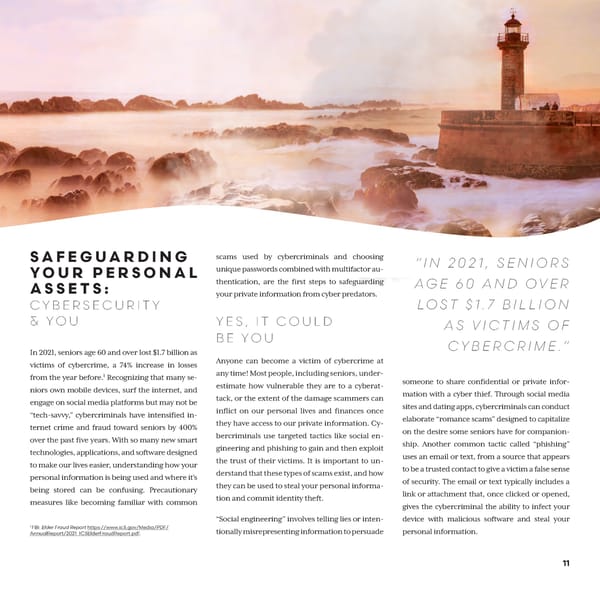11 1 FBI: Elder Fraud Report https://www.ic3.gov/Media/PDF/ AnnualReport/2021_IC3ElderFraudReport.pdf . SAFEGUARDING YOUR PERSONAL ASSETS: CYBERSECURITY & YOU In 2021, seniors age 60 and over lost $1.7 billion as victims of cybercrime, a 74% increase in losses from the year before. 1 Recognizing that many se- niors own mobile devices, surf the internet, and engage on social media platforms but may not be “tech-savvy,” cybercriminals have intensified in - ternet crime and fraud toward seniors by 400% over the past five years. With so many new smart technologies, applications, and software designed to make our lives easier, understanding how your personal information is being used and where it's being stored can be confusing. Precautionary measures like becoming familiar with common scams used by cybercriminals and choosing unique passwords combined with multifactor au - thentication, are the first steps to safeguarding your private information from cyber predators. YES, IT COULD BE YOU Anyone can become a victim of cybercrime at any time! Most people, including seniors, under- estimate how vulnerable they are to a cyberat - tack, or the extent of the damage scammers can inflict on our personal lives and finances once they have access to our private information. Cy - bercriminals use targeted tactics like social en - gineering and phishing to gain and then exploit the trust of their victims. It is important to un - derstand that these types of scams exist, and how they can be used to steal your personal informa - tion and commit identity theft. “Social engineering” involves telling lies or inten - tionally misrepresenting information to persuade someone to share confidential or private infor - mation with a cyber thief. Through social media sites and dating apps, cybercriminals can conduct elaborate “romance scams” designed to capitalize on the desire some seniors have for companion- ship. Another common tactic called “phishing” uses an email or text, from a source that appears to be a trusted contact to give a victim a false sense of security. The email or text typically includes a link or attachment that, once clicked or opened, gives the cybercriminal the ability to infect your device with malicious software and steal your personal information. “IN 2021, SENIORS AGE 60 AND OVER LOST $1.7 BILLION AS VICTIMS OF CYBERCRIME.”
 Journey to Retirement Microsite Page 12 Page 14
Journey to Retirement Microsite Page 12 Page 14